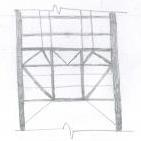Leaderboard
Popular Content
Showing content with the highest reputation since 04/01/24 in all areas
-
Do you or you company undertake structural design to Eurocodes?
Waqar Saleem and one other reacted to Simple Structures for a topic
Design Codes: I am interested in hearing if structural engineers in Pakistan are undertaking design to European Eurocodes? Or is it all to the American Codes? The Pakistan Building code is not much use. (If you or your company are a Eurocodes design expert, then refer to my profile for contact details). I work overseas and see (and have used) many Structural Engineers and Consulting Companies in India who are proficient in producing design deliverable (GA drawings, detail drawings, analysis, calculations etc) to Eurocodes. They undertake designs for all European countries from India. Great for the company and the country. You can download guides for these codes free online. I would suggest you study Eurocode 1, Eurocode 2 and Eurocode 3 as a minimum to begin with. This will help guide you to design buildings safely, and give you lots of good background information. Each European Country, including Turkey and other countries like Malaysia, Hong Kong use Eurocodes for design. Great for you professional development. Also, Each country have their own National Annexe (specific parameters to the country) to go with these codes. I suggest in Pakistan you use either refer to Turkish or Malaysian National Annexes. Below are the codes (Eurocodes) I am referring to: Hope the list below is useful reference. Eurocode 1: Actions on Structures BS EN 1991-1-1: Actions on structures. General actions. Densities, self-weight, imposed loads for building BS EN 1991-1-2: Actions on structures. General actions. Actions on structures exposed to fir BS EN 1991-1-3: Actions on structures. General actions. Snow load BS EN 1991-1-4: Actions on structures. General actions. Wind action BS EN 1991-1-5: Actions on structures. General actions. Thermal action BS EN 1991-1-6: Actions on structures. General actions. Actions during execution BS EN 1991-1-7: Actions on structures. General actions. Accidental action BS EN 1991-2: Actions on structures. Traffic loads on bridge BS EN 1991-3: Actions on structures. Actions induced by cranes and machine BS EN 1991-4: Actions on structures. Silos and tank Eurocode 2: Design of Concrete structures BS EN 1992-1-1: Design of concrete structures. General rules and rules for building BS EN 1992-1-2: Design of concrete structures. General rules. Structural fire design BS EN 1992-2: Design of concrete structures. Concrete bridges. Design and detailing rule BS EN 1992-3: Design of concrete structures. Liquid retaining and containing structure Eurocode 3: Design of Steel structures BS EN 1993-1-1: Design of steel structures. General rules and rules for building BS EN 1993-1-2: Design of steel structures. General rules. Structural fire design BS EN 1993-1-3: Design of steel structures. General rules. Supplementary rules for cold-formed members and sheeting BS EN 1993-1-4: Design of steel structures. General rules. Supplementary rules for stainless steel BS EN 1993-1-5: Design of steel structures. Plated structural element BS EN 1993-1-6: Design of steel structures. Strength and Stability of Shell Structure BS EN 1993-1-7: Design of steel structures. Plated structures subject to out of plane loading BS EN 1993-1-8: Design of steel structures. Design of joint BS EN 1993-1-9: Design of steel structures. Fatigue BS EN 1993-1-10: Design of steel structures. Material toughness and through-thickness properties BS EN 1993-1-11: Design of steel structures. Design of structures with tension component BS EN 1993-1-12: Design of steel structures. Additional rules for the extension of EN 1993 up to steel grades S 70 BS EN 1993-2: Design of steel structures. Steel bridge BS EN 1993-3-1: Design of steel structures. Towers, masts and chimneys. Towers and mast BS EN 1993-3-2: Design of steel structures. Towers, masts and chimneys. Chimney BS EN 1993-4-1: Design of steel structures. Silo BS EN 1993-4-2: Design of steel structures. Tank BS EN 1993-4-3: Design of steel structures. Pipeline BS EN 1993-5: Design of steel structures. Pilin BS EN 1993-6: Design of steel structures. Crane supporting structures Eurocode 4: Design of Composite Steel and Concrete structures BS EN 1994-1-1: Design of composite steel and concrete structures. General rules and rules for building BS EN 1994-1-2: Design of composite steel and concrete structures. General rules. Structural fire design BS EN 1994-2: Design of composite steel and concrete structures. General rules and rules for bridge Eurocode 5: Design of Timber structures BS EN 1995-1-1: Design of timber structures. General. Common rules and rules for building BS EN 1995-1-2: Design of timber structures. General. Structural fire design BS EN 1995-2: Design of timber structures. Bridges Eurocode 6: Design of Masonry structures BS EN 1996-1-1: Design of masonry structures. General rules for reinforced and unreinforced masonry structure BS EN 1996-1-2: Design of masonry structures. General rules. Structural fire design BS EN 1996-2: Design of masonry structures. Design considerations, selection of materials and execution of masonry BS EN 1996-3: Design of masonry structures. Simplified calculation methods for unreinforced masonry structure Eurocode 7: Geotechnical Design BS EN 1997-1: Geotechnical design. General rule BS EN 1997-2: Geotechnical design. Ground investigation and testing Eurocode 8: Design of structures for earthquake resistance BS EN 1998-1 Design of structures for earthquake resistance. General rules, seismic actions and rules for building BS EN 1998-2: Design of structures for earthquake resistance. Bridge BS EN 1998-3: Design of structures for earthquake resistance. Assessment and retrofitting of building BS EN 1998-4: Design of structures for earthquake resistance. Silos, tanks and pipeline BS EN 1998-5: Design of structures for earthquake resistance. Foundations, retaining structures and geotechnical aspect BS EN 1998-6: Design of structures for earthquake resistance. Towers, masts and chimney Eurocode 9: Design of aluminium structures BS EN 1999-1-1: Design of aluminium structures. General structural rule BS EN 1999-1-2: Design of aluminium structures. Structural fire design BS EN 1999-1-3: Design of aluminium structures. Structures susceptible to fatigue BS EN 1999-1-4: Design of aluminium structures. Cold-formed structural sheeting BS EN 1999-1-5: Design of aluminium structures. Shell structure2 points -

Enhancing Knowledge Sharing: The Importance of Forums
Waqar Saleem reacted to Hamza Irshad for a topic
I have been a regular user of this forum and have learned a lot of topics and concepts from the discussions led by our seniors. However, it seems that over the past two years, the activity on this forum has decreased due to the creation of WhatsApp groups for structural engineering discussions. While WhatsApp groups provide quick answers, they lack proper documentation. Discussions on WhatsApp quickly vanish in the chat history, whereas this forum maintains a record of valuable discussions. Engineers may ask questions in WhatsApp groups for quick responses, but continuing the discussion on this forum ensures that valuable insights are documented and accessible for current and future reference.1 point -

Guide for Response Spectrum Analysis
Muhammad Faizan reacted to Osama Anwar for a topic
Assalaam o Alliakum everyone, I was wondering if someone could refer me some guide/learning material/book/video tutorials to design building by applying response spectrum analysis in ETABS. I am designing a building with extreme torsional irregularity. Seismic Design Category is D and T<3.5T_s so ELF can't be used. I have to apply some dynamic analysis. I know basics of RSA but I want a step-by-step guide to design structure using RSA in ETABs. Any help would be appreciated.1 point -

Need structural design engineering training.
Waqar Saleem reacted to UmarMakhzumi for a topic
Apply to local offices. Islamabad has a lot of forms! Make sure you get sucked into a company that keeps you on u paid internships. Entertain paid jobs only. Apart from that, read code, books and literature. Good Luck. Thanks .1 point -

Stiffness Modifiers
Haseeb Ur Rehman Raja reacted to Badar (BAZ) for a topic
Both practices, with and without stiffness modifiers, are followed to decide about the reinforcement requirement against the design forces. Both approaches will lead to a stable structure as long as mechanics holds. Having said that, the stiffness-modifier approach is more conservative, and is better representation of the actual conditions in most cases; one would expect columns to be less cracked than beams, and consequently will attract larger share of unbalanced moments at beam-column joint as compared to un-cracked scenario.1 point -

Construction Of Special Moment Resisting Frame
Muhammad Hashim reacted to UmarMakhzumi for a topic
Its more than that. You have to see what seismic zone your building lies and have to select the appropriate level of ductility and over-strength. I would recommend skimming through ACI Chapter 21. I have also attached some documents pertinent to the discussion that will help you develop a better understanding of aforesaid. Go through read them and if you have any question post in the forums Goodluck! How do Beam-Column Joints in RC Buildings Resist Earthquakes.pdf How do Columns in RC Buildings Resist Earthquakes.pdf How to make building ductile for Good Seismic Performace.pdf How do Earthquake Affect Reinforced Concrete Buildings.pdf What is seismic design philosophy of Buildings.pdf1 point